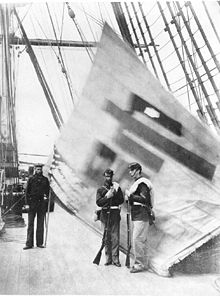The Sujagi is a flag with the hanja 帥, pronounced su in Korean, that denotes a commanding general. The whole term literally means, "Commanding general flag". Only one sujagi is known to exist in Korea. The color is a faded yellowish-brown background with a black character in its center. It is made of hemp cloth and measures approximately 4.15m x 4.35m.[1]
| Sujagi | |
 Sujagi captured in 1871 | |
| Korean name | |
|---|---|
| Hunminjeongeum | 수자기 |
| Hanja | 帥字旗 |
| Revised Romanization | Sujagi |
| McCune–Reischauer | Sujagi |


History edit
This type of flag was put in a fortress where a commanding general was located.[2] In the case of the extant sujagi in Korea, it represented General Eo Jae-yeon who, in 1871, commanded the Korean military forces on Ganghwa Island, which is off the northwest coast of present-day South Korea, near the capital of Seoul. It was captured by the United States Asiatic Squadron in June of that year during the United States' expedition to Korea.[3] As with other war prizes, it was put into the collection of the museum at the United States Naval Academy in Annapolis, Maryland.[4]
In October 2007, after many years of petitions by South Korea to the United States government, the flag was returned to South Korea on a long-term, ten-year loan.[5][6]
After being returned, it was displayed at the National Palace Museum of Korea in Seoul until 2009, when it was moved to the Ganghwa History Museum on Ganghwa Island.[7] As of September 2022, the lease had been renewed for the flag to stay in South Korea until at least October 2023.[8]
References edit
- Duvernay, Thomas A. (2021). Sinmiyangyo: The 1871 Conflict Between the United States and Korea. Seoul: Seoul Selection. pp. 172–174. ASIN B08VR9FFL1.
Notes edit
- ^ "신미양요 때 빼앗긴 어재연 장군기 '10년 장기대여' 귀환 : 뉴스". 23 October 2007. Retrieved 1 May 2017.
- ^ "Archived copy". Archived from the original on 2011-07-19. Retrieved 2009-02-12.
{{cite web}}: CS1 maint: archived copy as title (link) - ^ Carolyn A. Tyson (1 January 1966). Marine Amphibious Landing in Korea, 1871. Naval Historical Foundation. Retrieved 27 January 2015.
- ^ Hwang, Jurie (29 October 2010). "American campaigns for flag's return". The Korea Herald. Retrieved 29 September 2022.
- ^ Chung Ah-young (22 October 2007). "General's Flag Returns Home From US". The Korea Times. Retrieved 27 January 2015.
- ^ Bradley Olson (11 October 2007). "Korean flag to be returned on loan basis". Baltimore Sun. Retrieved 27 January 2015.
- ^ Jung, Jia H. (27 September 2022). "Repatriated flag runs out of time in Korea". The Korea Times. Retrieved 29 September 2022.
- ^ Kwak, Yeon-soo (29 September 2022). "Loan period extended for US-captured Joseon-era flag". The Korea Times. Retrieved 29 September 2022.